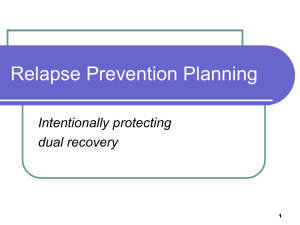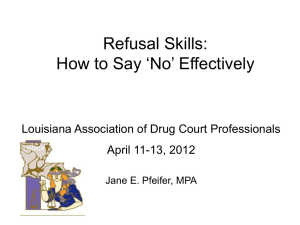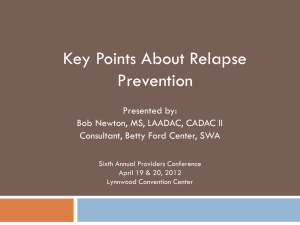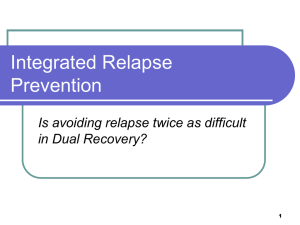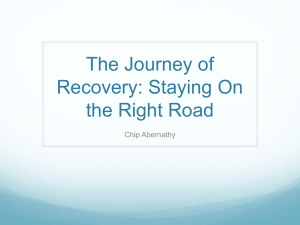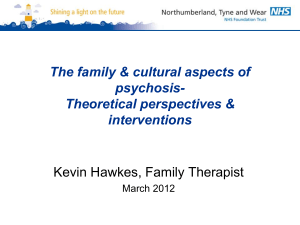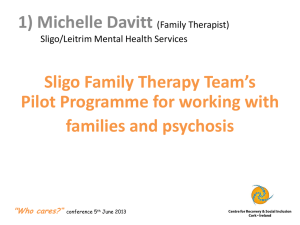Risk Factors for Relapse - Federation of State Physician Health
advertisement
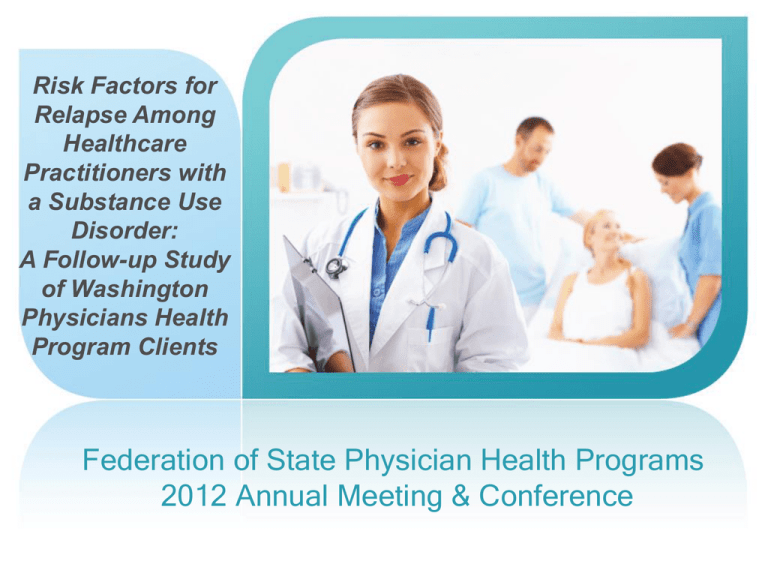
Risk Factors for Relapse Among Healthcare Practitioners with a Substance Use Disorder: A Follow-up Study of Washington Physicians Health Program Clients Federation of State Physician Health Programs 2012 Annual Meeting & Conference Presented by Amanda Buhl, MPH Mick Oreskovich, MD Research Coordinator, Washington Physicians Health Program Psychiatric Medicine Associates Gary Carr, MD Charles Meredith, MD Medical Director, Washington Physicians Health Program Associate Medical Director, Washington Physicians Health Program Washington Physicians Health Program Risk Factors for Relapse Among Healthcare Practitioners with a Substance Use Disorder: A Follow-up Study Background: Domino, et al.1 Background: Domino, et al.1 • • • • • N= 292 11 year follow-up period 25% had at least 1 relapse Family history increased risk (HR 2.29) Use of major opioid in presence of cooccurring psychiatric disorder increased risk (HR 5.79) • Presence of all three markedly increased risk (HR 13.25) • First relapse increased risk of subsequent relapse (HR 1.69) Background: McLellan, et al.2 Background: McLellan, et al.2 • • • • • N=904 5 years of data 72% completed or extended contract 81% had no incident of drug or alcohol misuse 78% were licensed and working at the end of the monitoring period • 95% of contract completers were licensed at the end of the monitoring period. Background: Skipper, et al.3 • N=83 Anesthesiologists compared to 697 Nonanesthesiologists from Blue Print Study Anesthesiologists Nonanesthesiologists P Value Positive Drug Tests 11% 23% 0.02 Reported to Board 18% 20% 0.77 Completed Contract 71% 64% 0.09 Licensed and Practicing Medicine 76% 73% 0.21 Background: Buhl, et al.4 • N= 144 Surgeons compared to 636 Nonsurgeons from Blue Print Study Surgeons Nonsurgeons P Value Positive Drug Tests 22% 21% 0.91 Reported to Board 19% 20% 0.70 Completed Contract 62.5% 65% 0.68 Licensed and Practicing Medicine 67% 75% 0.10 Did Not Return to Medicine 26% 17% 0.02 New WPHP data: 2002 - 2008 AIMS: • Examine relationships between previously demonstrated risk factors for relapse and relapse rates • Examine rates of relapse following program modifications New data: 2002 - 2008 Methods • N = 173 • Retrospective cohort design, 7 years of data • Excluded: – History of prior treatment – Previous clients – Those for whom outcome was not known • MD, DO, PA-C, DDS, DVM, DPM • Personal data collected including: demographics, drug use, health and psychiatric history, and professional information. • All components of study approved by the University of Washington IRB. New data: 2002 - 2008 Statistics • Survival Analysis methods: Cox proportional hazards regression model and log-rank test. • Relapse rate per 1000 person years in each program period: Phase I (0-2 years), Phase II (2-5 years), Phase 3: (5+ years) • Cross-tabulation with X2 test, t tests, or Mann-Whitney test were used to detect co-variates associated with risk factors for relapse. New data: 2002 - 2008 Results: Descriptive Characteristics N Age (years) MeanSD Range Age < 40 >= 40 Gender Female Male Specialty Anesthesiology Dentistry Emergency Medicine Family Medicine Internal Medicine/Sub-Specialty Psychiatry Physician Assistant Surgery/Sub-Specialty Access to IV Drugs No access to IV drugs Access to IV drugs % 4710 27-70 38 133 22% 78% 30 142 17% 83% 11 28 20 25 26 11 18 16 6% 16% 12% 15% 15% 6% 10% 9% 106 66 62% 38% New data: 2002 - 2008 Results: Descriptive Characteristics Drug of choice Alcohol Fentanyl Minor opioids Major opioids Other Smoker No Yes Family history No Yes Co-occurring disorders No Yes N % 103 4 32 16 17 60% 2% 19% 9% 10% 107 63 63% 37% 68 102 40% 60% 45 127 26% 74% New data: 2002 - 2008 Results: Descriptive Characteristics Co-occurring disorders Both axis 1 and axis 2 Axis 1 but not Axis 2 Axis 2 but not Axis 1 Neither axis 1 nor axis 2 Past Psych. Treatment None Outpatient only Inpatient Psych. Meds at enrollment No Yes Past lethal behaviors None Ideation Attempt N % 35 82 10 45 20% 48% 6% 26% 80 71 21 47% 42% 12% 82 86 49% 51% 118 40 12 69% 24% 7% New data: 2002 - 2008 Results: Relapse Rates Estimated 1-, 3- and 5-year cumulative relapse-free rate (%) for all subjects 1-year rate (95% CI) All subjects 3-year rate (95% CI) 86% (81%-92%) 82% (76%-88%) 5-year rate (95% CI) 79% (72%-87%) New data: Frequency of Relapse Frequency of Relapse* 2% 2% 1% 12% No Relapse 1 Relapse 2 Relapse 83% 3 Relapse 4 Relapse *For clients admitted 1/1/2002 – 12/31/2008 n=172 Domino & Buhl Data Buhl et al (only WPHP) Not yet published Domino et al (only WPHP) JAMA 2005 • • • • • • N= 292 over 11 years No Relapse = 75% Single Relapse = 17% Two or more = 8% Death = .6% Return to practice = 100% NR 61% One or more • Completion of 5 year contract = 86% • Chg of specialty = NA • • • • • • N=173 over next 7 years No Relapse = 82% Single Relapse = 13% Two or more = 5% Death = 1% (in remission) Return to practice = 100% NR 68% One or more • Completion of 5 year contract or still being monitored successfully = 95% • Chg of specialty = NA New data: 2002 - 2008 Results: Cox regression summary - all subjects Risk Factor Age <40 >=40 Gender Male Female Specialty Anesthesiology Dentistry Emergency Medicine Family Medicine Internal Medicine Psychiatry Physician Assistant Surgery Sub-Specialty Access to IV Drugs No access to IV Drugs Access to IV drugs N HR (95% CI) 38 133 ref. 1.75 (0.61-5.01) 142 30 ref. 0.72 (0.31-1.67) 11 28 20 25 26 11 18 16 0.42 (0.05-3.61) 1.26 (0.38-4.15) 0.79 (0.19-3.33) 1.50 (0.45-4.94) ref. 0.55 (0.06-4.74) 1.61 (0.47-5.56) 0.38 (0.04-3.31) 106 66 ref. 0.98 (0.47-2.03) p* 0.3 0.4 0.4 0.4 0.7 0.8 0.5 0.6 0.5 0.4 1 New data: 2002 - 2008 Results: Cox regression summary - all subjects Risk Factor Smoker No Yes Family history No Yes Co-occurring disorders No Yes Co-occurring disorders Not Axis 1 Axis 1 Co-occurring disorders Not Axis 2 Axis 2 Number of axis 2 diagnoses Co-occurring disorders Total number of diagnoses N HR (95% CI) p* 107 63 ref. 2.17 (1.06-4.46) 0.03 68 102 ref. 1.06 (0.51-2.21) 0.9 45 127 ref. 1.62 (0.62-4.25) 0.3 55 117 ref. 1.15 (0.51-2.59) 0.7 127 45 ref. 1.94 (0.93-4.03) 0.08 1.42 (1.04-1.93) 0.03 1.25 (0.97-1.60) 0.08 New data: 2002 - 2008 Results: Cox regression summary - all subjects Risk Factor Drug of Choice , Fentanyl and major opioids combined Alcohol Minor opioids Major opioids & fentanyl Other Drug of Choice: Fentanyl No Yes Drug of Choice: Fentanyl or major opioids No Yes Drug of Choice: Alcohol No Yes Any alcohol: Any use No Yes N HR (95% CI) p* 0.2 103 32 ref. 0.64 (0.24-1.69) 0.4 20 17 0.55 (0.16-1.85) 0.21 (0.03-1.59) 0.3 0.13 168 4 ref. 0.00 (0.00-Inf) 1 152 20 ref. 0.69 (0.21-2.27) 0.5 69 103 ref. 2.00 (0.91-4.38) 0.08 39 ref. 133 3.36 (1.02-11.12) 0.047 Next steps... • Examine relapse DOC • Increase N • Why alcohol? – legal gateway drug? • Importance of ETG? What we have learned • Remarkably low relapse rates: importance of tri-modal monitoring (unique PHP care model) • Smoking • Co-occurring disorders (Axis 2) • Alcohol (any use)? Study Limitations • Retrospective cohort design, observational • Sample size! – Small numbers within individual groups – Pooling Domino/Buhl data – Aggregating data from other PHPs • Multivariate models • Incidence of relapse underestimated because of loss of follow up (after 5 years) Future Questions • Increased sample size – (independent effects of specialty) • Recovery planning • Other factors (stress/burnout) that contribute to relapse • Patient harm/malpractice incidents Special thanks... • Mick Oreskovich, MD • Charles Meredith, MD • Gary Carr, MD • Nayak Polissar, PhD • Moni Blazej Neradilek, MS References 1. 2. 3. 4. Domino, K B, Hornbein TF, Polissar NL, et al. Risk factors for relapse in health care professionals with substance use disorders. JAMA. 2005;293(12):1453-1460. McLellan T, Skipper GE, Campbell M, DuPont R. Five year outcomes in a cohort study of physicians treated for substance use disorders in the United States. British Medical Journal 2008;337:a2038 doi:10.1136/bmj.a2038. Skipper GE, Campbell MD, DuPont RL. Anesthesiologists with substance use disorders: A 5year outcome study from 16 state physician health programs. Anesthesia and Analgesia. 2009;109:891-896. Buhl A, Oreskovich MR, Meredith CM, et al. Prognosis for the recovery of surgeons from Chemical Dependency. Archives of Surgery. 2011;146(11):1286-1291.
